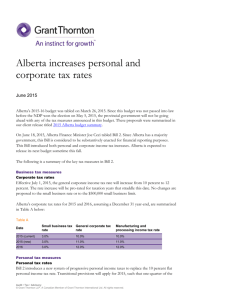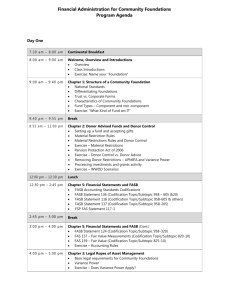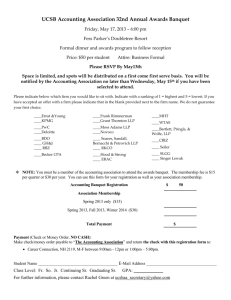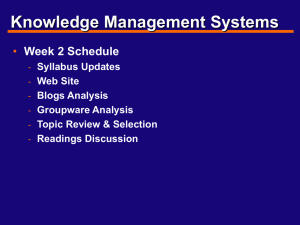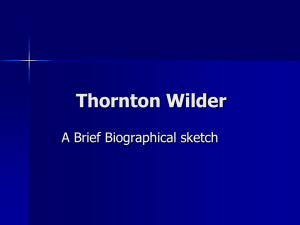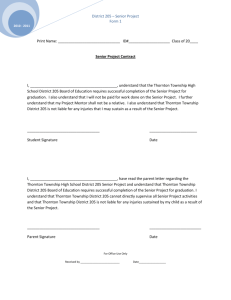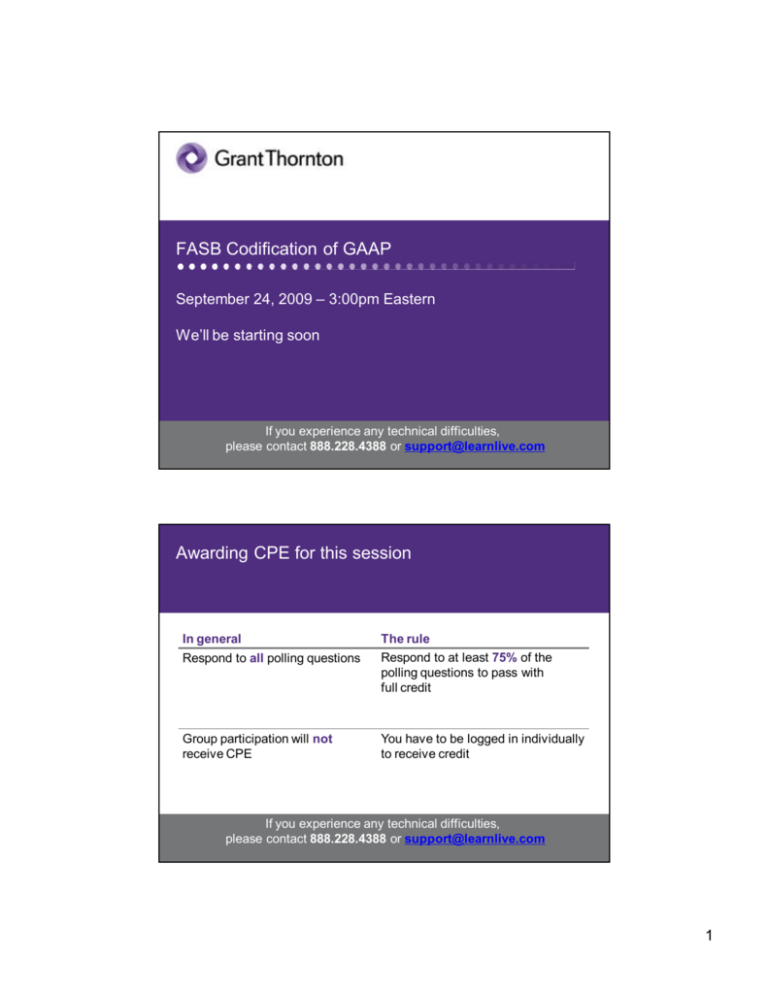
FASB Codification of GAAP
September 24, 2009 – 3:00pm Eastern
We’ll be starting soon
If you experience any technical difficulties,
please contact 888.228.4388 or support@learnlive.com
© Grant Thornton LLP. All rights reserved.
Awarding CPE for this session
In general
Respond to all polling questions
The rule
Respond to at least 75% of the
polling questions to pass with
full credit
Group participation will not
receive CPE
You have to be logged in individually
to receive credit
If you experience any technical difficulties,
please contact 888.228.4388 or support@learnlive.com
© Grant Thornton LLP. All rights reserved.
2
1
Addressing your questions through Q&A
Step 1
Step 2
If you experience any technical difficulties,
please contact 888.228.4388 or support@learnlive.com
© Grant Thornton LLP. All rights reserved.
3
Other helpful features you can use
If you experience any technical difficulties,
please contact 888.228.4388 or support@learnlive.com
© Grant Thornton LLP. All rights reserved.
4
2
Welcome
Lynne Triplett
Ryan Brady
Partner, Accounting Principles
Consulting Group
Chicago
Manager, Accounting
Principles Consulting Group
Chicago
© Grant Thornton LLP. All rights reserved.
5
Learning objectives
• Describe the FASB’s objectives in developing the
Codification
• Describe what is included in and excluded from the
Codification, and how it is structured
• Describe how the Codification facilitates research
• Describe what actions you should take as a result of the
Codification
© Grant Thornton LLP. All rights reserved.
6
3
Agenda
• What is the Codification?
– Purpose
– Content
– Structure
• What does the Codification launch mean to you?
– Research
– Updating documentation
© Grant Thornton LLP. All rights reserved.
8
Description
• The FASB Accounting Standards Codification™
(“Codification”) is the single source of authoritative
nongovernmental U.S. GAAP, except for SEC guidance
• It is included in a topical online research system
• It eliminated levels a through d GAAP and replaced with
authoritative and nonauthoritative
• SEC rules and interpretive releases are also authoritative
GAAP for SEC registrants
© Grant Thornton LLP. All rights reserved.
9
4
Why FASB developed the Codification
• To address weaknesses identified in previous GAAP
structure
– U.S. GAAP was unwieldy, difficult to understand, and
difficult to use
– Appropriate authoritative guidance was difficult to
retrieve under previous structure, with numerous
authoritative standards from various standard-setters
• To simplify standard-setting process and align with FASB’s
objectives
© Grant Thornton LLP. All rights reserved.
10
Benefits of the Codification
• All non-SEC authoritative guidance in one place
• Updates and additions to guidance will be incorporated into
appropriate topics rather than by standard setter
• Users can have more confidence that all authoritative
guidance has been reviewed or considered in researching
an accounting matter
© Grant Thornton LLP. All rights reserved.
11
5
Statement 168
• FASB Statement 168, The FASB Accounting Standards
Codification™ and the Hierarchy of Generally Accepted
Accounting Principles, established the Codification as the
sole source of authoritative nongovernmental U.S. GAAP
• Statement 168 supersedes Statement 162, which defined
the U.S. GAAP hierarchy prior to the Codification (Levels a
through d)
• Statement 168 was the last numbered Statement that the
FASB will issue
© Grant Thornton LLP. All rights reserved.
12
Effective date and transition
• The Codification was launched
on July 1, 2009
• The Codification is effective for
financial statements for interim
and annual periods ending after
September 15, 2009
© Grant Thornton LLP. All rights reserved.
13
6
Effective date and transition
• Significant transitional issues are
not expected, except if a nonpublic
entity is adopting the AICPA TIS
guidance on software revenue
recognition
• Transition and effective date
guidance is provided for nonpublic
entities adopting AICPA TIS on
software revenue recognition
© Grant Thornton LLP. All rights reserved.
14
Changes
• Codification was not intended
to change U.S. GAAP
• Language from the original pronouncements was edited for
consistency and certain words were changed (for example,
“should” and “must” were replaced with “shall”)
• If you believe that adoption of the Codification requires a
change in accounting policy, consult with your accountants
© Grant Thornton LLP. All rights reserved.
15
7
Guidance included in the Codification
• Standards included in Levels a – d of the
previous U.S. GAAP hierarchy
• Guidance from the FASB, EITF,
Derivative Implementation Group,
Accounting Principles Board, and AICPA
• Certain guidance that was not previously
considered authoritative GAAP has been
included in the Codification and thus
made authoritative
© Grant Thornton LLP. All rights reserved.
17
Guidance included in the Codification
• SEC guidance is included in the
Codification for convenience
• SEC guidance presented in the
Codification is not complete
• SEC continues to have authority for
updating and amending SEC
accounting guidance
© Grant Thornton LLP. All rights reserved.
18
8
Guidance included in the Codification
AICPA Technical Inquiry Service (TIS)
guidance for software revenue
recognition (Section 5100 paragraphs
38-76) has been elevated for non-SEC
registrants
© Grant Thornton LLP. All rights reserved.
19
Guidance excluded from the Codification
• Governmental accounting standards
• Standards that were outdated or
superseded as of December 31, 2008
• Grandfathered material
• Guidance for non-GAAP matters such
as cash or income tax basis accounting
© Grant Thornton LLP. All rights reserved.
20
9
Ongoing standard setting process
• The Codification will be updated by Accounting Standards
Updates (ASUs) issued by the FASB
• These will include:
– Background
– Basis for conclusions
– Update instructions
• ASUs are not authoritative in their own right
• ASUs may be accessed via the FASB website
• ASUs are numbered by the year and a sequential identifier
(for example, 2009-01)
© Grant Thornton LLP. All rights reserved.
22
Ongoing standard setting process
• No change to FASB due process
• Guidance will continue to be exposed for comment in the
same manner as prior to the launch of the Codification
• EITF will continue to deliberate issues on its agenda and
reach consensuses-for-exposure
• Regardless of the standard-setter that exposes the
guidance for comment (FASB, EITF), it will be incorporated
into the Codification via an ASU
© Grant Thornton LLP. All rights reserved.
23
10
Structure
Areas and Topics
General
Principles
Presentation
Assets
Balance
Sheet
(210)
Receivables
(310)
Generally
Accepted
Accounting
Principles
(105)
Revenue
Broad
Transactions
Industry
Business
Combinations
(805)
Not-for-Profit
Entities
(958)
Leases
(840)
Software
(985)
Revenue
Recognition
(605)
Risks and
Uncertainties
(275)
Investments
– Debt and
Equity
Securities
(320)
24
© Grant Thornton LLP. All rights reserved.
Structure
Leases
(840)
Topic
Overall
(10)
Subtopic
Scope
(15)
Section
Subsection
© Grant Thornton LLP. All rights reserved.
Lessees
Operating
(20)
Capital
(30)
Disclosure
(50)
Lessors
25
11
Structure
Sections
Section
Name
Section
Name
00
Status
30
Initial Measurement
05
Background
35
10
Objectives
Subsequent
Measurement
15
Scope
50
Disclosure
20
Glossary
55
Implementation
Recognition
65
Transition
25
© Grant Thornton LLP. All rights reserved.
26
Agenda
• What is the Codification?
– Purpose
– Content
– Structure
• What does the Codification launch mean to you?
– Research
– Updating documentation
© Grant Thornton LLP. All rights reserved.
28
12
Codification changes
• How you reference
accounting guidance
• How you research
accounting issues
29
© Grant Thornton LLP. All rights reserved.
Referencing
To reference guidance from the Codification, the convention is to
refer to “FASB ASC” followed by the topic, subtopic, section, and
paragraph(s)
Guidance
Reference
Leases - Topic
FASB ASC 840
Operating leases - Subtopic
FASB ASC 840-20
Lessees subsections in operating
leases subtopic
FASB ASC 840-20, “Lessees”
subsections
Disclosure requirements section
in operating leases subtopic
Specific disclosure requirements
at the paragraph level
FASB ASC 840-20-50
© Grant Thornton LLP. All rights reserved.
FASB ASC 840-20-50-1 through 50-2
30
13
Accessing the Codification
$
FASB
basic view
© Grant Thornton LLP. All rights reserved.
FASB
professional view
Printed
version
33
Research
© Grant Thornton LLP. All rights reserved.
34
14
Research
© Grant Thornton LLP. All rights reserved.
35
Research
© Grant Thornton LLP. All rights reserved.
36
15
Research
© Grant Thornton LLP. All rights reserved.
37
Research
© Grant Thornton LLP. All rights reserved.
38
16
Research
Joining sections
Example: Join “Scope” sections under the “Leases” topic
Topic
Leases
Subtopic
Section
Overall
Scope
Disclosure
Operating
Scope
Capital
Disclosure
Scope
Disclosure
39
© Grant Thornton LLP. All rights reserved.
Research
Combining subsections
Example: Combine “Lessees” subsections under the
“Operating” subtopic
Subtopic
Operating
Section
Subsection
© Grant Thornton LLP. All rights reserved.
Scope
Lessees
Disclosure
Lessors
Lessees
Lessors
40
17
Actions you need to take
• Obtain access and become familiar with
the Codification
• Update references in accounting policies
and disclosures
• Discuss anticipated changes with auditors
– Evaluate whether it is an error or a
change resulting from change to
literature
© Grant Thornton LLP. All rights reserved.
41
Updating policies and disclosures
• Accounting policy documentation should be updated to
replace legacy references to authoritative literature
• Financial statement disclosures must be updated to replace
legacy references to authoritative literature
– Plain English
– Codification references
© Grant Thornton LLP. All rights reserved.
42
18
Disclosures - original
Since September 1, 2005, the Company has recorded
compensation expense for its employee stock options and share
purchase rights in accordance with the provisions of Statement
of Financial Accounting Standards (“SFAS”) No. 123R,
“Share-Based Payment” (“SFAS No. 123R”). Compensation
expense is recognized over the requisite service period for awards
of equity instruments to employees based on the grant-date fair
value of those awards expected to ultimately vest (with limited
exceptions). Forfeitures are estimated on the date of grant and
revised if actual or expected forfeiture activity differs materially
from original estimates.
© Grant Thornton LLP. All rights reserved.
43
Disclosures – revised, plain English
Compensation expense is recognized over the requisite service
period for awards of equity instruments to employees based on
the grant-date fair value of those awards expected to ultimately
vest (with limited exceptions). Forfeitures are estimated on the
date of grant and revised if actual or expected forfeiture activity
differs materially from original estimates.
© Grant Thornton LLP. All rights reserved.
44
19
Disclosures – revised, Codification references
Since September 1, 2005, the Company has recorded
compensation expense for its employee stock options and share
purchase rights in accordance with the provisions of FASB ASC
718, Compensation – Stock Compensation. Compensation
expense is recognized over the requisite service period for awards
of equity instruments to employees based on the grant-date fair
value of those awards expected to ultimately vest (with limited
exceptions). Forfeitures are estimated on the date of grant and
revised if actual or expected forfeiture activity differs materially
from original estimates.
© Grant Thornton LLP. All rights reserved.
45
Accounting changes
• If an accounting change results from adopting the
Codification, it should be accounted-for as a change in
accounting principle or correction of an error under ASC
250, Accounting Changes and Error Corrections
• We don’t expect that there will be changes in accounting
principles due to the Codification, outside of those related
to nonpublic entities’ adoption of portions of AICPA TIS
5100
© Grant Thornton LLP. All rights reserved.
46
20
Summary
Questions?
• What is the Codification?
– Purpose
– Content
– Structure
• What does the Codification launch mean to you?
– Research
– Updating documentation
© Grant Thornton LLP. All rights reserved.
48
Resources
• Grant Thornton On the Horizon
bulletins (May 4 - July 20)
• Grant Thornton New Developments
Summary 2009-27
• FASB Notice to Constituents
• FASB and AICPA websites
© Grant Thornton LLP. All rights reserved.
49
21
Wrap up
• Launch of Codification marks a significant shift
in how we research and reference accounting guidance
• Access Codification and become familiar with its
functionality
• Begin referencing accounting guidance using the
Codification referencing scheme
• Discuss Codification with your auditors
© Grant Thornton LLP. All rights reserved.
50
Any final questions or comments?
Please type in your questions at any time.
© Grant Thornton LLP. All rights reserved.
51
22
Thank you for attending.
Visit us online at www.GrantThornton.com.
After the program:
Respond to online evaluation form
Print your CPE Certificate from a CPE confirmation email
Note: Group participation will not receive CPE
Download today’s slides as a reference resource
For questions regarding your CPE certificate, contact Learnlive at
888.228.0988
© Grant Thornton LLP. All rights reserved.
23


